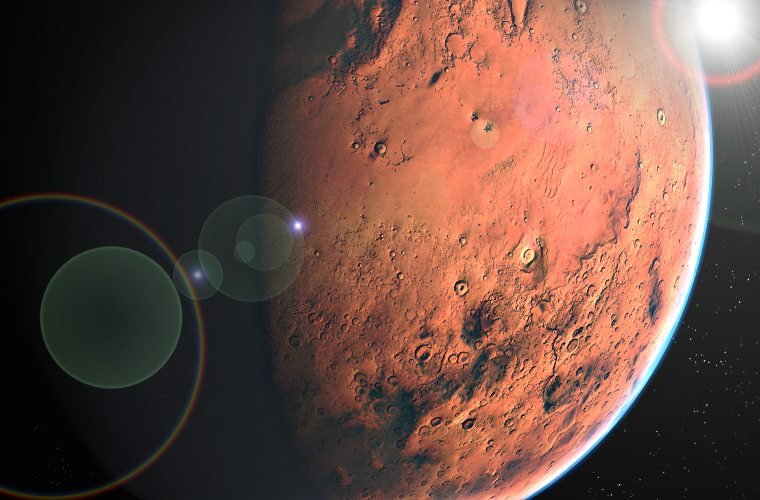Mars’ inner structure has been unveiled by the international team of NASA’s InSight mission. Using the SEIS (Seismic Experiment for Interior Structure) very broadband seismometer, the team detected and analyzed a dozen marsquakes that revealed clues to the composition of the planet.
“These three studies provide important constraints on the present-day structure of Mars and are also key for improving our understanding of how the planet formed billions of years ago and evolved through time,” write Sanne Cottaar and Paula Koelemeijer, co-authors of a related article in Science magazine. Moreover, one researcher involved in the study told The Debrief that some of the findings may require “out-of-the-box thinking,” because Mars’ core has some curious characteristics.
Background: InSight and The Journey to Mars
The InSight mission (an acronym for Interior Exploration Using Seismic Investigations, Geodesy, and Heat Transport) landed on Mars at the end of 2018 and has been collecting seismic data since early 2019.
The study of a planet’s interior layers—its crust, mantle, and core—can expose its formation and evolution. Seismologists first measured waves diving through the mantle of Earth in 1889 from an earthquake in Japan. In the following decades, seismologists discovered the main layers of Earth. Now, they are on track to achieving a similar feat on Mars.
Central to the team’s research is the SEIS very broadband seismometer, an instrument that uses three highly sensitive pendulums to detect even the tiniest movements on the Martian surface.


Measuring ground movements on Mars comes with an array of challenges. The SEIS can sense movement along three axes and across frequency, but its recordings are only obtained at a single location. This limits how well SEIS can pinpoint marsquake epicenters and timings, according to Cottaar and Koelemeijer’s article.
The geology of Mars also presents a challenge to researchers. The planet’s rocky soil surface complicates the identification of waves for the seismometer.
To overcome these issues, seismologists worked together with a broad team of planetary scientists specializing in geochemistry, mineral physics, geodynamics, and petrology—the study of rocks—to finetune the results.
Analysis: What is Mars Made Of?
Just like Earth, Mars is a multi-layered planet. Researchers found evidence for up to three interfaces on the planet, with the average thickness of Mars’ crust ranging between 24 and 72 kilometers (km) and its mantle to a depth of nearly 800 km.
Their findings also show that a thick lithosphere rests close to 500 km below the surface and, like Earth, it likely has a low-velocity layer beneath it.
Moving deeper, researchers found that Mars’ liquid metal core has a radius of about 1,830 km and begins roughly halfway between the planet’s surface and center, which indicates that its mantle consists of only one rocky layer instead of two, differentiating it from Earth.
Notably, the findings also show that Mars’ iron-nickel core is less dense than previously thought and that it’s also enriched in lighter elements. In an email to The Debrief, Amir Khan, one of the researchers, writes, “These observations have fueled speculation that Mars might represent a stranded planetary embryo that depicts the chemical characteristics of the solar nebular at the location of the orbit of Mars.”
Planetary embryos are bodies that existed when the solar system was forming, when it was gas and dust with the infant sun at its center. Earth, like Mars, was made out of embryos. But unlike Mars, Earth was made slowly from embryos that collided. Mars, as a stranded planetary embryo, according to speculation, wouldn’t have required the colliding embryos and therefore could’ve been formed much earlier in the history of the solar system.
Outlook: Drilling Deeper
The question of how all these light elements got into the core is one that researchers are still pondering and may require “out-of-the-box thinking,” Khan told The Debrief. But the InSight team is moving forward, and deeper; they are looking to see if an inner solid core exists like in Earth.
By observing the interiors of Mars, researchers can better understand the planet’s evolution and reveal more of its mysteries.
Candy Chan is a journalist based in New York City. She recently graduated from Barnard College with a degree in History. Follow her reporting on her Twitter @candyschan.
Don’t forget to follow us on Twitter, Facebook, and Instagram, to weigh in and share your thoughts. You can also get all the latest news and exciting feature content from The Debrief on Flipboard, and Pinterest. And subscribe to The Debrief YouTube Channel to check out all of The Debrief’s exciting original shows: DEBRIEFED: Digging Deeper with Cristina Gomez –Rebelliously Curious with Chrissy Newton

